#Sumerian Cylinder Seals
Video
youtube
Project Looking Glass | The Time Warriors of the 2012 Apocalypse
#youtube#The Why Files#Majestic 12#MJ 12#Project Looking Glass#Illuminati#Sumerian Cylinder Seals#wormholes#stargates#portals#UFO#UFOs#Area 51#Project Aquarius#remote viewing#time travel
3 notes
·
View notes
Photo
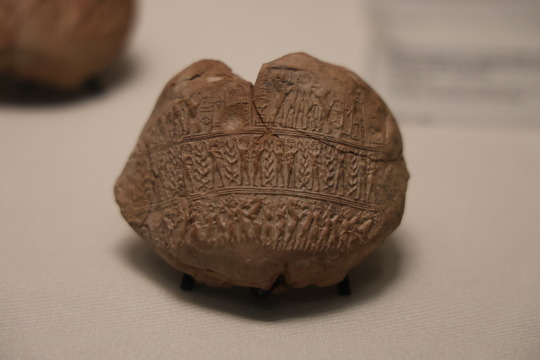
Seal impression of Baranamtara, queen of Lagash
Excavated at Tello (ancient Girsu), Iraq
Early Dynastic IIIb period, ca. 2400-2350 BCE
Musée du Louvre
#baranamtara#lagash#girsu#tello#mesopotamia#sumerian#early dynastic#cylinder seal#art history#archaeology#louvre
4 notes
·
View notes
Text
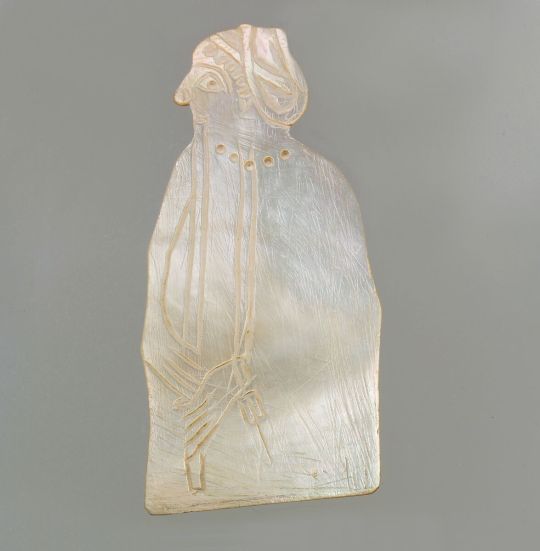
as per usual going insane over historical artifacts in order to stay sane about humanity source
#she's wearing a cylinder seal on a bracelet on her wrist!!!!!!#sumerian#ancient sumer#okay when i typed in that tag the suggestion was 'ancient sumeria' u all know that's... that's not what its called right#ancient hyperfixation#antiquity
0 notes
Photo


A Large Collection of Near Eastern Cylinder Seals, and other Near Eastern objects
Circa 4000-500 B.C.
including Jemdet Nasr, Uruk, Sumerian, Neo-Babylonian, Akkadian, Assyrian and Mitannian, engraved in lapis lazuli, serpentine, hematite, marble, and other stones, comprising a wide variety of subjects, as well as several Bactrian bronze stamp seals.
#Near Eastern Cylinder Seals Circa 4000-500 B.C.#ancient seals#ancient artifacts#archeology#archeolgst#history#history news#anicent history#ancient culture#ancient civilizations
582 notes
·
View notes
Text
Submitted via Google Form:
What is the earliest point in evolution could humans evolve written language? Let's say biologically, human evolution was similar to reality, could say Neanderthals have written language already? Like before civilisations began? Also, written language is certainly not only for the elite. In fact, it got started in various families and then got spread among the tribes. So we have thousands of different tribes and familes across the world - each with their own languages and writing systems. Of course, there are some similarities as people have travelled a bit and met neighbouring tribes. So basically before society was properly formed into civilisations, there should already be writing but civilisation is actually what prodded society to centralise communications and languages. Does this work? Basically, I just want a society that had writing from much earlier on than reality and figuring out how it could have been done.
Tex: Writing is developed, much like any other tool, as a function of necessity. If it’s not necessary for a society to develop it, then writing won’t exist for them. Civilisation is also, as a concept, prone to periodic re-defining as we accumulate more data and our perceptions of the data shift (for example, one could define the pinnacle of civilisation as taxes, where before another defined it as religion).
Writing also has exceptionally little to do with biology as writing is a social construct meant to fill a void found in one’s culture. Consequentially, writing can also encompass a broad range of intentional markings that demonstrate specific meanings, from tally marks, to standardized pictures, to ideograms, to glyphs.
What does your world need writing for? What niche does it fill? What were the people using as its predecessor, and what happened to cause them to change systems? Did the scope of their needs change, or did the perception of their needs change? What information is important for them to record, on a societal and personal level? Who teaches writing? Who learns it? What is the method of transmission, and for those that teach writing, is it their sole occupation or something on the side?
Utuabzu: Writing is old. Really old. At least 5000 years old. This seems a long time, but humans have been living in permanent settlements and practicing forms of agriculture in West Asia for about 9000 years. Homo sapiens has been around for at least 300,000 years. But only in the last few thousand years, in a handful of places, did humans independently come up with the idea that the spoken word could be preserved using symbols that others could be trained to decipher.
The earliest writing as far as we can tell is cuneiform, from Sumeria in what is now southern Iraq. It may or may not have had some influence on the development of Egyptian hieroglyphs from pictographs to an actual script - we have found Sumerian cylinder seals in very early Egyptian sites, indicating that the two groups were in contact. But from these two points the idea of writing spread through the Mediterranean and West Asia. The Indus Valley civilisation also used a script, but we are unable to decipher it and have relatively few examples to work from, so we cannot tell if it even is a true script or if it predates contact with Sumeria.*
Shang Dynasty China also developed the earliest form of Chinese script from the Oracle Bone tradition not long after this. This also spread, together with Chinese ideas, agricultural and governmental practices across much of eastern Asia.
Meanwhile cuneiform script was adopted by a wide range of cultures in West Asia, and inspired other scripts like Elamite, Old Persian and Ugaritic, which while using similar shapes were structured very differently. Egyptian hieroglyphs inspired Anatolian hieroglyphs and were later in the early Iron Age the basis that the Phoenician alphabet** - ancestor of alphabetic, abjad and abugida scripts from the Philippines to Iceland - was derived from.
Another place we see writing develop entirely independently is in Central America, where a pictographic system was employed from the Olmec period all the way through to the 16th Century, but only became a true script in the Mayan region [at time, need to check when]. The system employed elsewhere in Mesoamerica did not have the capacity to accurately render speech, so far as we are aware.***
There are also a handful of other instances that might or might not be examples of true scripts developing entirely independently, from rorotongo on Rapanui to the quipus of the Andes to [pretty sure there's one in central africa, but can't remember the name just now]. We simply don't have enough information to be certain about any of them. Oftentimes, because the media they were written on does not survive all that well, or was deliberately destroyed.
But something you should bear in mind is that complex societies don't necessarily require writing for a lot of their history. Many of the most impressive cultures of the ancient world were not widely or at all literate. There's no indication that the Mississippian culture that built sites like Cahokia had writing, nor did Teotihuacán or the various cultures of the Andes. There's no evidence of writing at Great Zimbabwe, nor at Jomon sites in Japan.
Even in cultures that did have writing, it was frequently not a widely known skill. Your average ancient Egyptian couldn't read hieroglyphs, and Chinese hanzi still take years to master. This is part of why so many traditional scripts were displaced in the 19th and early 20th century. Most people couldn't read them and when authorities decided to use Roman or Cyrillic or something else in mass education, it very quickly became much more widely understood than the traditional script.
To my knowledge, there's no examples of a pre-agricultural society developing writing independently. Some have derived scripts from those they came into contact with, or made entirely unique ones inspired by writing they knew of. But so far as I am aware, none have ever created a script entirely from scratch with no prior exposure to the concept of writing.
*the Sumerians appear to have called the Indus Valley Civilisation 'Meluhha', and were actively trading with it from at least the Bronze Age. Ur III records even tell of a colony of Meluhha merchants at Guabba, near Lagaš, and Sumerian cylinder seals have been found in Indus Valley sites.
**actually an abjad.
*** the conquistadors burned almost all pre Columbian codices, so we can't ever be 100% certain that no other variants of the system developed into true scripts. But it's unlikely.
23 notes
·
View notes
Text
Some people have asked me why I believe the Ark of the Covenant is an electrostatic device, and I would encourage them to look into the work of Maurice Denis-Papin, who was a descendant of the famous inventor, and who determined that the Ark was capable of holding 500-700 volts per vertical meter when contained in a dry space, dischargeable to the earth by means of it's garlands- and this is even before it has a superconductive substance in it like monoatomic atoms (manna), and before it is placed in something like the Great Pyramid, which has its own electrostatic potential. I would also point out Bruce Rux's research in his book Architect of the Underworld, where he mentions:
"The story of the flood is the conclusion of one of those mythical, epic conflicts. There were others. Sitchen pieces together the story of two civil wars in his work, "The Pyramid Wars", taken largely from the Sumerian "Myths of Kur" tablets, the Lugal-e epic, F.Hrozny's "Mythen von dem Gotte Ninib", J.Bollenrucher's "Gebete und Hymnen an Nergal", and George A. Barton's "Miscellaneous Babylonian Texts", as well as fragmentary tablets from the region. These texts constitue strong evidence for the two Great Pyramids at Giza having been in existence long before Egyptology claims they were. A cylinder seal shows the symbol of Ninurta (Horus) with a victory wreath, between two objects which could only be pyramids- not only are they triangles, bit they are composed of tiers of rectangular blocks. Reference to one of these is given as "the mountains the gods assembled". Inside it were lethal "stones" , with which "the Great Serpent" nearly killed Ninurta in his battle against (the serpent), with their "strong power". ..to "grab and kill, with a tracking which seizes". The "stones" glowed in the dark in different colors, set in various recesses which may be found in the Great Pyramid....one of the weapons was a net, the device of which was located in a secret chamber in the Pyramid." It should also be pointed out that the ancient name of the Sphynx is ARQ UR, possibly related to where the name "Ark" itself came from...
Now even if such an Ark wasn't placed in the Great Pyramid, but instead was placed in a tabernacle in the dessert with WOOL curtains, which, of course, pick up static on their own, then what do you think the Ark would do inside that location? It would just absorb more static electricity of course, until it began to discharge out of the top- as the "presence of God!" Our Order has found six arks, and we know where there is another four, and it is possible that there were hundreds in the ancient world before they got melted down for the previous metals... This reasonably suggests that they were being used for that electrostatic potential in different ways. They are depicted all over the Egyptian temple walls...yet people only think of the Torah or Old Testament when discussing it...
4 notes
·
View notes
Text
The Royal Tombs of Ur is a 5,800-year-old Sumerian burial site of around 2,000 graves located in the ancient city of Ur in southern Mesopotamia (in the south of modern day Iraq). Sixteen of the graves were designated as ‘royal’ due to the spectacular treasures inside, including gold beads, bronze relics, cylinder seals, musical instruments and ceramics, as well as artifacts associated with mass ritual.
54 notes
·
View notes
Photo

Cylinder seal with goddesses Ninishkun, the subject of three hymns attributed to Enheduanna, and Ishtar, Mesopotamia, Akkadian, Akkadian period (ca. 2334–2154 BCE),
Cuneiform inscription: “To the deity Niniškun, Ilaknuid, [seal]-cutter, presented (this), Limestone”
This cylinder seal was dedicated to a little-known goddess, Ninishkun, who is shown interceding on the owner's behalf with the great goddess Ishtar. Ishtar places her right foot upon a roaring lion, which she restrains with a leash. The scimitar in her left hand and the weapons sprouting from her winged shoulders indicate her war-like nature.
Poet Enheduanna (ca. 2300 BCE), the earliest-named author in world literature. Bringing together a spectacular collection of her texts alongside other works made circa 3400–2000 BCE.
Enheduanna received her name, which means “high priestess, ornament of heaven” in Sumerian, upon her appointment to the temple of the moon god in Ur, a city in southern Mesopotamia, in present-day Iraq.
The daughter of the Akkadian king Sargon, Enheduanna left an indelible mark on the world of literature by composing extraordinary works in Sumerian. Her poetry reflected her devotion to the goddess of sexual love and warfare — Inanna in Sumerian, Ishtar in Akkadian.
Whereas much of ancient Mesopotamian literature is unattributed, Enheduanna introduced herself by name and included autobiographical details in several poems. Her passionate voice had a lasting impact in Mesopotamia, as her writings continued to be copied in scribal schools for centuries after she died.
The Oriental Institute of the University of Chicago, acquired 1947; A27903.
Text courtesy: Hyperallergic
#art#design#tablet#enheduanna#priestess#sumeria#mesopotamia#iraq#royal#poetry#king sargon#history#style#inanna#ishstar#akkadian#cylinder#ninishkun
76 notes
·
View notes
Text
We can only guess at what an average smith in Ur or a shepherd in Akkad felt about the Old Akkadian Empire’s rise and fall. Even for the elites, their lives are most often captured only by brief snapshots, such as the cylinder seals that attest to their existence and little else. That is part of the intrigue that clings to Enheduana’s poems. ‘The Exaltation’ seems to offer a personal account of the political drama of the Old Akkadian period, told by the daughter of the emperor herself. Enheduana was not so much an eyewitness to the insurrection as the eye of its storm.
9 notes
·
View notes
Text
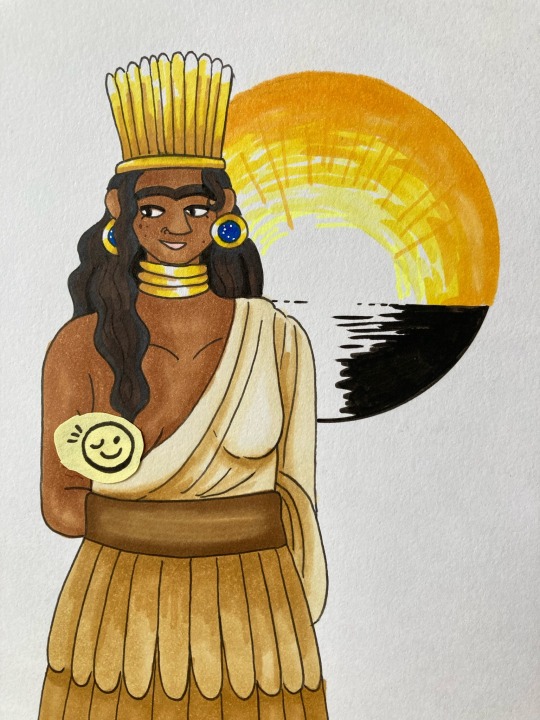
Day 14: Aya
The “Lady of the Dawn” an archetypical divine bride. In Mesopotamia proper she was regarded as married to Shamash/Utu the sun god. Her Sumerian name was Sherida. She was also adopted into and had popularity in the Hurrian pantheon, where she was known under the name Nin-Aya and was married to the Hurrians sun god Simige.
In her depictions on cylinder seals she usually has a tiered dress, but I’ve drawn those a lot already so I decided to draw her in Hurrian garb. Aside from the garments in the seals she sometimes has a breast exposed, which I assumed is too risqué for tumbr so it’s getting censored 😅
#Aya#annunaki#inktober2022#mesopotamian mythology#mythtober2022#lots more to be learned about her#last year when I drew shamash I was unaware of her existence for some reason
14 notes
·
View notes
Text
What If… Listicles Are Actually an Ancient Form of Writing and Narrative?
James Vincent on One of Humanity’s Oldest Writing Systems
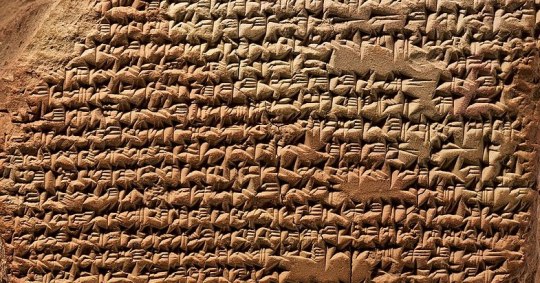
by James Vincent
Measurement was a crucial organizing principle in ancient Egypt, but metrology itself does not begin with nilometers. To understand its place in human culture, we have to trace its roots back further, to the invention of writing itself. For without writing, no measures can be recorded. The best evidence suggests that the written word was created independently thousands of years ago by a number of different cultures scattered around the world: in Mesopotamia, Mesoamerica, China, and Egypt. But it’s in Mesopotamia—present-day Iraq—where the practice is thought to have been invented first.
A brief sketch of the origin of writing goes like this: in the beginning there was the Thing, and the Thing needed counting. What the Thing was doesn’t matter much. A flock of sheep, perhaps, or sheaves of barley: profits of the new system of settled agriculture, which had allowed cities with tens of thousands of occupants to appear for the first time in history. The women and men who dwelt in these cities wanted to keep track of their new wealth and decided to use clay tokens for the job.
These tiny objects, the size of game pieces, were shaped as cones, discs, triangles, and cylinders and can be found scattered throughout the archaeological record like errant dice. The earliest date back to 7500 BC, in what would become the Mesopotamian civilization of Sumer, home of the Sumerians. The tokens seem to have been useful, as they multiply in form and number over the centuries. As city life became more varied in Mesopotamia, with inhabitants trading not only raw materials like wool and metal, but also processed goods like oil, beer, and honey, more tokens were created to represent these resources.
Their appearance became more complex, with scratches added to their surface, adding a graphic element to their meaning. Fast forward a few millennia, and, like a shopper burdened with too much pocket change, the Mesopotamians were fed up with their clutter of tokens. To better organize them, they began making clay containers known asbullaeto enclose them into groups. Thesebullaestarted appearing around 3500 BC, as bumpy spheres the size of tennis balls, filled with clay tokens and sealed like a baby’s rattle. Onebullacould then be used to track multiple items.
READ MORE
8 notes
·
View notes
Text
Ancient Sumerian cylinder seal impression showing the god Dumuzid being tortured in the Underworld by galla demons
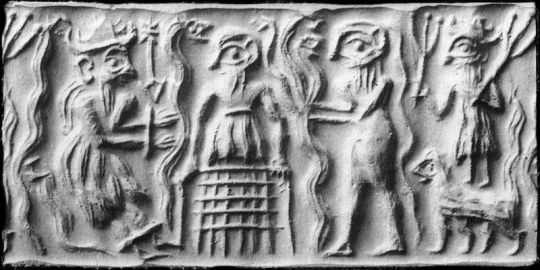
3 notes
·
View notes
Text
Thrilling archaelogical dicoveries
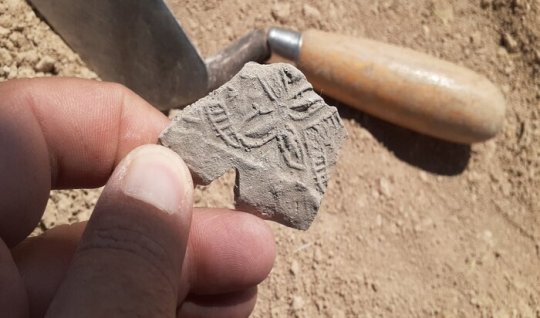
TEHRAN—Archaeologists in western Iran have found over 1,000 clay seals (and fragments) along with other “important” relics estimated to date from the Elamite era (3200–539 BC).
“We unearthed arrays of important objects such as over 1,000 clay seals while conducting an urgent excavation on an archaeological hill in Kermanshah province,” IRNA quoted archaeologist Shokouh Khosravi as saying on Monday.
Moreover, a number of earthen animal figurines and counting objects belonging to the early Elamite culture have been discovered in these excavations, Khosravi, who leads the excavations said.
“Those objects are unique in their kind in western Iran,” she said.
The archaeologist said those findings mark the first archaeological materials of the Elamite period in the west of the central Zagros region
“The finding triggers fundamental changes in our understanding and knowledge about the situation of western Iran in the fourth millennium BC,” Khosravi stated.
During the excavation, which is authorized by the Research Institute of Cultural Heritage and Tourism, a large number of clay door locks, hundreds of pieces of container seals, and a cylinder seal were also found, which shows the site was an administrative center for organizing economic and exchange affairs in the early Elamite period, she explained.
“As the excavations continue, more information will be obtained about the nature and absolute history of settlement on the site.”

Experts say the Kermanshah region has had one million years of archaeological continuity, which is due to the geographical features such as a high number of springs and fertile soil.
Elam, or the Elamite kingdom, was one of the most impressive civilizations of the ancient world. Its territory was once in a region, which is now situated in the modern Iranian provinces of Ilam and Khuzestan.
However, according to sources, it was never a cohesive ethnic kingdom or polity but rather a federation of different tribes governed at various times by cities such as Susa, Anshan, and Shimashki until it was united during the Middle Elamite Period, briefly, as an empire.
The name Elam was given to the region by others– the Akkadians and Sumerians of Mesopotamia–– and is thought to be their version of what the Elamites called themselves– Haltami (or Haltamti)– meaning “those of the high country.” 'Elam', therefore, is usually translated to mean“highlands” or “high country” as it comprised settlements on the Iranian Plateau that stretched from the southern plains to the elevations of the Zagros Mountains.
Susa was formerly the capital of the Elamite Empire and later an administrative capital of the king of Achaemenian Darius I and his successors of 522 BC. Throughout the late prehistoric periods, Elam was closely tied culturally to Mesopotamia. Later, perhaps because of domination by the Akkadian dynasty (c. 2334–c. 2154 BC), Elamites adopted the Sumero-Akkadian cuneiform script.
Documents from the second period, which lasted from the 16th to the 8th century BC, are written in cuneiform; the stage of the language found in these documents is sometimes called Old Elamite. The last period of Elamite texts is that of the reign of the Achaemenian kings of Persia (6th to 4th century BC), who used Elamite, along with Akkadian and Old Persian, in their inscriptions. The language of this period, also written in the cuneiform script, is often called New Elamite.
Although all three stages of Elamite have not been completely deciphered, several grammatical features of the language are known to scholars. These include a plural formation using the suffix -p, the personal pronouns, and the endings of several verb forms.
Elamite language is an extinct language spoken by the Elamites in the ancient country of Elam, which included the region from the Mesopotamian plain to the Iranian Plateau. According to Britannica, Elamite documents from three historical periods have been found. The earliest Elamite writings are in a figurative or pictographic script and date from the middle of the 3rd millennium BC.
Just to notice how the name Elam was written, n the various languages of the ancient times: Liner Elamite:hatamti Cuneiform Elamite: 𒁹𒄬𒆷𒁶𒋾 ḫalatamti; Sumerian:𒉏𒈠 elam; Akkadian:𒉏𒈠𒆠 elamtu,hebrew:עֵילָם ʿēlām, Old persian:𐎢𐎺𐎩 hūja
Source: https://www.tehrantimes.com/news/489442/Amazing-archaeological-finds-dating-back-to-Elamite-era-unearthed
#Iran#ancient Persia#archaelogy#Kermanshah#Khuzestan province#Susa Iran#Elamite#Zagros mountain#archaeologist#TehranTimes#Travel Iran#ancient city#ایران#Tehrantimes
1 note
·
View note
Link
0 notes
Text
There is something curious about the national flags of the planet Earth. The flag of the United States has fifty stars; the Soviet Union and Israel, one each; Burma, fourteen; Grenada and Venezuela, seven; China, five; Iraq, three; São Tomé e Príncipe, two; Japan, Uruguay, Malawi, Bangladesh and Taiwan, the Sun; Brazil, a celestial sphere; Australia, Western Samoa, New Zealand and Papua New Guinea, the constellation of the Southern Cross; Bhutan, the dragon pearl, symbol of the Earth; Cambodia, the Angkor Wat astronomical observatory; India, South Korea and the Mongolian Peoples’ Republic, cosmological symbols. Many socialist nations display stars. Many Islamic countries display crescent moons. Almost half of our national flags exhibit astronomical symbols. The phenomenon is transcultural, nonsectarian, worldwide. It is also not restricted to our time: Sumerian cylinder seals from the third millenium B.C. and Taoist flags in prerevolutionary China displayed constellations. Nations, I do not doubt, wish to embrace something of the power and credibility of the heavens. We seek a connection with the Cosmos. We want to count in the grand scale of things. And it turns out we are connected—not in the personal, small-scale unimaginative fashion that the astrologers pretend, but in the deepest ways, involving the origin of matter, the habitability of the Earth, the evolution and destiny of the human species.
#Cosmos#Carl Sagan#astronomy#science#cosmology#evolution#atypicalreads#nonfiction#history#space#philosophy#classics#popsci#stars#planets#galaxy#solar system#astrobiology#astrophysics#space science#1980s#quotes#natural selection#artificial selection#universe#scientific method#1980
0 notes
Photo
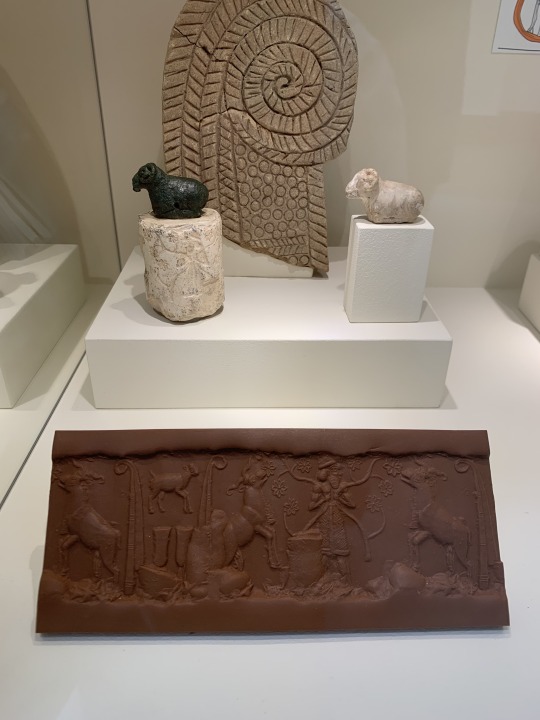
Cylinder seal and modern impression: bearded man in net skirt feeding two goats with reed ringed-pole symbols of the goddess Inanna
Ca. 3300-3000 BCE
Uruk (Warka, Iraq)
Vorderasiatisches Museum, Staatliche Museen zu Berlin
153 notes
·
View notes